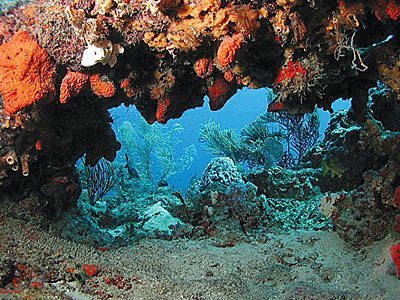The picture didn’t match the name. The small red sea horse didn’t look like a juvenile pygmy sea horse even if that’s what the photographer said it was, and even if it was found on a gorgonian fan, which is where you’d find a pygmy sea horse if you were inclined to look for one. But there was no bulbous snout, or tubercles, or three rings on the tail, all of which you’d expect to see in a Hippocampus bargibanti.
Well, then, if it’s not H. bargibanti, what is it? If you’re a taxonomist, you worry about these things. Especially when you’re writing a sea horse identification guide. So there sat sea horse scientists Sara Lourie, Amanda Vincent, and Heather Hall, with a bunch of questions and no answers — and no Corpus dilecti to examine as evidence.
It’s no wonder that several years later, while doing field work for her doctoral dissertation in Indonesia, Lourie couldn’t help but look for the little buggers. Imagine her surprise when she found several hiding among the branches of gorgonian sea fans. Then imagine when she discovered the smallest of them was pregnant. Well, now. These aren’t juvenile anything.
Ladies and gentlemen, meet Hippocampus denise, the world’s newest sea horse — and, at less than 2 cm from nose to tail — also its smallest.
“I always imagined all the species in the world had been named,” says Lourie, who earned the honor of naming the new critter after Denise Tackett, the underwater photographer who sent that curious picture. “But there are quite a few out there that haven’t been identified yet.”
Apparently so — discovering a new species is surprisingly common these days, given that only a handful of scientists are actually looking to add to the rolls of living creatures. Within the past two years, new species of coral, fish, phytoplankton, giant jellyfish, and a whale — yes, a whale — have been discovered. Some, such as H. denise, were there all along; they were just misidentified. Others swam under the radar until a particularly observant scientist happened to be in the right place at the right time.
As a result, between 200 and 300 new species of fishes are “described” in the scientific literature each year, thereby officially becoming a new species. But that’s only a fraction of the unidentified species that are actually collected. The difference comes from the strict process scientists like Lourie have to go through to ensure that what they’re looking at isn’t a rose by any other name. It also says something about how we think about natural science.
Naming Names
The act of naming plants and animals was formalized in the 18th century, and it’s traced back to Swedish naturalist Carl Linnaeus. As his colleagues scoured the world on their historic voyages of discovery and collection, Linnaeus and other scientists at European universities were left to name the array of creatures and plants. Considering that even common plants often had more than one “scientific” name, this was no small task.
Linnaeus used a system whereby collections of animals with similar traits were collected into a hierarchical system of classification, in family-tree fashion. Genera (more than one genus) were collected into orders, orders grouped into classes, and classes into kingdoms. That’s the basic framework used today, though modern scientists have added to it. In 1758, he published the 10th edition of his encyclopedia of animal names, Systema Naturae. This was the first time he used a binomial naming system — genus and species — and since he adhered to his own classifications most religiously, when other scientists didn’t, its publication is considered the birth of scientific nomenclature, with him as its patriarch.
Under the Linnaeus system, Lourie’s sea horse belongs in Kingdom Animalia, Phylum Chordata (because it has a spinal chord), Class Actinopterygii (fishes with ray-fins), Subclass Neopterygii (modern ray-finned fishes), Division Teleostei (modern bony fishes), Subdivision Euteleosti (advanced bony fishes), Superorder Acanthopterygii (spiny-rayed fishes), Order Gasterosteiformes (includes sticklebacks, tubesnouts, and sand eels), Suborder Syngnathoidei (fishes with tube-shaped snout), Family Syngnathidae (sea horses and pipefishes), and Genus Hippocampus (fishes with horselike heads and prehensile tail). In polite company, it’s all shortened to Hippocampus denise.
At its most basic definition, a species designates a separate species, or a population of individuals that can interbreed and produce offspring that can also reproduce. Think baby horse (Equus caballus) versus baby mule (a hybrid, noted as Equus assinus x Equus caballus). Usually, they evolve in different geographical areas, and often they’ll fill similar ecological niches, say, on a reef. Do note that this definition isn’t without its exceptions. For example, cichlids can breed with other species of cichlids creating fertile hybrids. Meanwhile, sticklebacks from different geographical locations won’t readily breed with other sticklebacks of the same species if they grew up in different conditions, such as shallow and deep water.
The Challenge
Presently, there are about 25,000 species and subspecies of fishes, according to the Catalog of the Species of Fishes, maintained by the California Academy of Sciences. Actually, according to the catalog, there are about 53,000 named fishes, but about half of those are duplicates — fishes “rediscovered” by other scientists, often in different parts of the world. Herein lies the challenge. Is that unidentified finned object indeed a new species, or does it match something that’s already on a shelf in a museum somewhere, pale and pickled under 50 years of dust?
“You need an extensive knowledge of the group just to recognize that it might be new and to be able to say you can’t identify it to anything you know,” says Jeff Williams, collection manager in the Division of Fishes at the Smithsonian Institution’s National Museum of Natural History, who has named a few species of his own. “And most of the time you aren’t able to see it’s a new species underwater.”
The first step, after collecting samples from, often as not, a location no one in his or her right mind would consider diving, is a thorough scouring through all the biological literature that could conceivably have published a description of your animal since 1758, to see if anything sounds familiar. If it’s in the literature, it’s probably also in a museum somewhere, waiting for closer scrutiny.
If that sounds tedious, it is, Williams says. It pays to be lucky. In Lourie’s case, someone already did the legwork; in 1915 a German scientist named Duncker published his monograph Revision der Syngnathidae, eliminating all the known duplicates in the family incurred over the previous 150-odd years. That kind of living right can save a decade of research, Williams says.
When the unidentified fish is determined to be true cryptic ichthyofauna (literally, “hidden fish”), a sample is analyzed to craft a formal description of the species. That single sample becomes the holotype, the perfect older sibling that all subsequent examples are compared against. It is the heir, stored for perpetuity in preservative goo. The spares are called paratypes, and they show some of the natural variation you’ll see in a given species. Please don’t let anything happen to the holotype-in-a-jar, or some poor soul will have to prove the paratype is indeed identical to the departed holotype, thus declaring that sample the neotype. For the record, Lourie’s holotype — a female — and her paratypes are stored in the Museum Zoologicum Boboriense in Cibinong, Indonesia, the Bishop Museum in Hawaii, the Smithsonian Institution National Museum of Natural History in Washington, D.C., the Australian Museum in Sydney, and the Museum of Victoria, Melbourne, Australia.
The analysis is nearly as tedious as the literature review. Among other things, Lourie measured head length, trunk length, eye diameter, coronet height, snout length, dorsal fin length, tail length, width of trunk, and the depth of the trunk at several points along the fish, and compared the proportions of those measurements, then compared all of that with two similar species — H. bargibanti and H. minotaur (bullneck sea horse). She analyzed an X-ray to count the number of trunk rings and tail rings, and she counted the number of rays in the dorsal, pectoral, and anal fins — all on an animal about the size of a thumbnail.
Those measurements, taken as a whole, make up the scientific description that shows how this fish is different from any look-alike cousins. With data in hand, Lourie and collaborator John Randall, senior ichthyologist (emeritus) at the Bishop Museum, put fingers to keyboard to write a research paper to present their findings to the world. “A New Pygmy Seahorse, Hippocampus denise (Teleostei: Syngnathidae) from the Indo-Pacific” was published in the journal Zoological Studies last summer. And so, there are now 33 species of sea horse.
With all the Hoopus scientificus researchers must jump through, it’s a little surprising the process happens even 200 times a year. “It’s overwhelming,” says Williams, who might be working on a dozen or more species at a time, typically fishes from the Pacific Rim. “I don’t have time to work on different taxa.”
Actually, there aren’t many people who describe fish — by one estimate, there may only be about 500 scientists in the world who specialize in taxonomy. It’s expensive work, and it’s not en vogue anymore, Williams says. It’s a science of the 19th century, while in the 21st century research funding goes to ecologists who describe — and attempt to fix — unhealthy ecosystems, not identify each individual component of that system. According to a recent National Academy of Sciences study, we know of less than 10 percent of the biodiversity found on a reef. Not that fixing ecosystems isn’t important, but in a way, trying to do anything with only a little knowledge of what’s supposed to be there is like cooking a gourmet dinner without a recipe and only the peanut butter and cream of mushroom soup left over in your pantry. Or like building a house out of cards.
“The basic data gathering of what we have in the world isn’t being emphasized,” he says. “We really need to know the stocks of food eaten by the fish, eaten by the fish, eaten by the fish we eat. If they disappear, you’ll wipe out all the species. And you can’t do comparative biology if you don’t know what you’re comparing.”
In other words, it’s hard to study fish ecology, diversity, relationships, life history, and population biology — or to improve our understanding of the effects of human activities on marine life — if we don’t know exactly what we’re looking at. Lourie’s H. denise is a perfect example of that. It’s not the first adult that was thought to be a juvenile of another species. That’s a good way to do bad science. And then there are all those sea creatures out there that may be the source of new drugs to fight human diseases.
Given that there are some very real threats to those as-yet unknown fishes, scientists are eager to get identification work done quickly, even if it’s only a few more a year. “My guess is we’ll probably have 35,000 species [of fishes], possibly even more,” Williams says. “But it could all disappear before we know it’s there.”
And if you’re a taxonomist, you worry about these things.
For More Information
“Seahorses: An Identification Guide to the World’s Species and Their Conservation,” written by Sara A. Lourie, Amanda C.J. Vincent and Heather J. Hall, and published by Project Seahorse, London
“A New Pygmy Seahorse, Hippocampus denise (Teleostei: Syngnathidae) from the Indo-Pacific,” written by Sara A. Lourie, and John E. Randall and published in the April 2003 issue of the journal Zoological Studies.






